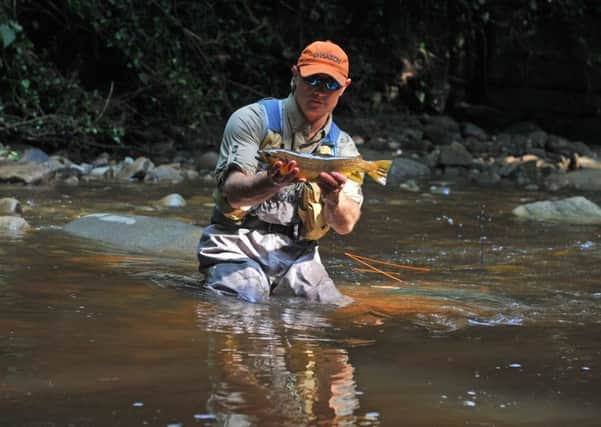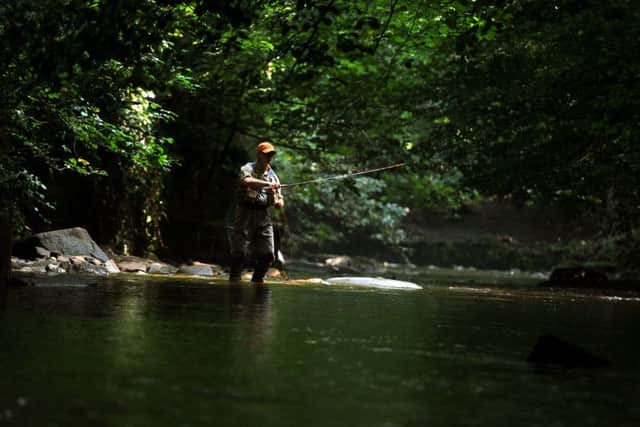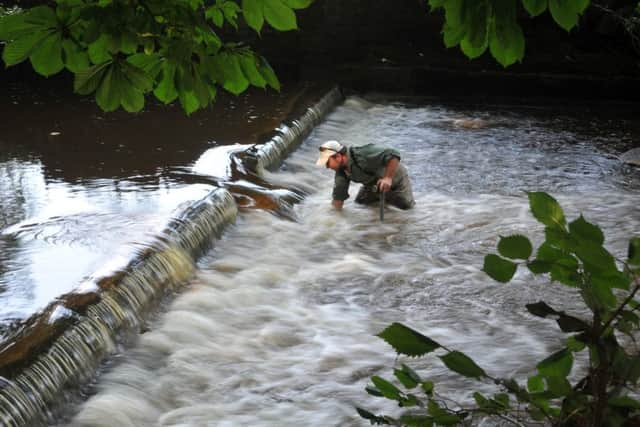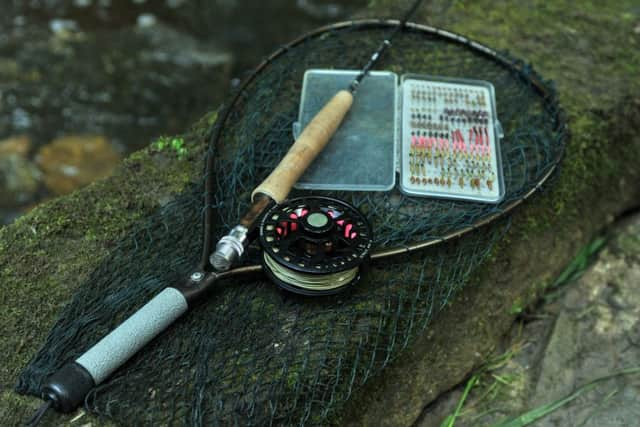Can Yorkshire's rivers pass a clean bill of health?


There is a romance about rivers. Something to do with the water itself, starting its journey out in the wildest parts of our landscape, then making its way down through the hills, the villages and towns, and finally the cities before escaping into the vastness of the sea.
But while we all like to see rivers in our landscape, maybe hang over bridges to watch the water passing through, most of us know precious little about what goes on beneath their surface. Which is odd given our historical dependency on these water courses, for powering our mills and factories during the industrial revolutions, to taking away our waste as our urban conurbations grew.
Advertisement
Hide AdAdvertisement
Hide AdThe hard fact is that right now, in Yorkshire, 84 per cent of rivers fail to meet the standards laid down by the Water Framework Directive (WFD), a piece of European legislation that sets down minimum requirements for inland and coastal water bodies. Most of our rivers are failing for at least one of three reasons: modifications due to now redundant industrial processes, pollution caused by poor agricultural practices, and insufficient fish populations.


Projects are underway throughout the county to restore these rivers to health. One is Eastburn Beck, a small tributary of the River Aire that runs alongside Lyndhurst Wood, just north of Keighley.
It’s a stretch of water well-known to Stuart Minnikin, a professional Dales fly fishing guide and ex-England international who takes his clients on the famous Yorkshire rivers such as the Wharfe and the Nidd. Minnikin has fished some of the biggest and finest rivers the world, but his own angling journey began here, on this scrappy little beck. As a child he lived within half a mile of Lyndhurst Wood and first fished it with a discarded sea rod he’d found when on a family holiday in Cornwall.
“This is a historically straightened and heavily constrained post-industrial spate river, walled on both sides, and there is a whole series of step weirs,” says Professor Jon Grey of the Wild Trout Trust, a conservation charity and one of the partners involved in the restoration project alongside the Environment Agency. “There was actually a very large mill on the bank opposite, and so many of those weirs would have been to try and control the river, and also to provide pools for off-take for water that in the past would have been used in the factories.”
Advertisement
Hide AdAdvertisement
Hide AdIt is these weirs – legacies of long-gone industries – that can be so damaging to a river’s health. And Yorkshire’s rivers are full of them. Eastburn Beck, for instance, has eight over this mile-long stretch.


Weirs might look pretty, but the ecological damage they can do can be far-reaching. They act as a physical barrier to fish wanting to move up the rivers for breeding, but they also have a dramatic effect on the river bed itself by slowing up the flow and causing it to silt up over time, which in turn can affect the insect life in the river, and so the birds and fish that feed on them, and so on.
“We can’t take the complete weir out,” says Grey, “But by ‘notching’ them, we are focusing the flow through the weirs, and by retaining the structure on each side of the notch, we are forcing the water to move around that structure and therefore create scour or deposition behind or above it.”
So cutting out a section of the weir isn’t just getting the water moving again, but the river bed too, flushing through the silt and sorting the finer gravel that fish need to successfully spawn and insects need to complete their life cycles.
Advertisement
Hide AdAdvertisement
Hide AdMinnikin’s job today is to relive his childhood on the Beck and it isn’t long before a beautiful, 2lb brown trout takes his dry fly, just in time for the cameras. This is a fine wild fish by any river’s standards, and it is soon photographed and released again, fit to fight – and more importantly breed – another day. But the purpose of this restoration work is not primarily to create a playground for anglers, though that is a happy by-product if you happen to fish the fly.


The wild brown trout – recently voted the nation’s favourite fish on BBC TV’s Springwatch – is what ecologists call a ‘sentinel’ species. This means that if the river environment has the water quality and can support a healthy population of wild brown trout at all stages of its life cycle – from the fine gravels needed for spawning, to the cover needed to protect the fry, to the holes and shady spots required by the adult fish, and of course support a good supply of insects for the fish to eat – then all is well with the river, and the requirements of the WFD will most likely be met.
These restoration projects are organised on a Catchment Based Approach (CaBA) which means they follow the rivers and natural landscape rather than some arbitrary administrative boundary. Such an approach not only encourages cooperation between different bodies, it positively demands it. Eastburn Beck, for example, involves the Environment Agency (EA), Wild Trout Trust, Woodlands Trust, Wildlife Trust and the Aire’s Rivers Trust. Each of these bodies brings its own bank of knowledge and small army of volunteers to deliver the work on the ground.
Pete Turner is the EA fisheries officer and manager of the award-winning Upper Aire Project which is five years into its eight year cycle. Working with the Aire’s Rivers Trust and the Wildlife Trust, the project has seen volunteers planting 80,000 willow trees to create a wet woodland, and put up more than eight miles of fencing to keep cattle out of the becks.
Advertisement
Hide AdAdvertisement
Hide AdAt its best, a project gets the go ahead and the conservation bodies cluster around it, all offering their own area of expertise, so the Wild Trout Trust might advise on fish passage on a river and the Woodland Trust on tree management beside it, for example. “The more people you have in there the more bang for your buck you get.” says Turner. “Lots of people who are aware of the project are now wanting to bolt on to it.”


While natural flood management was never the primary aim of the Upper Aire project (which was reducing agricultural pollution and improving fish numbers) it is it seems a by-product, the tree planting contributing to ‘slowing the flow’ of the river by reducing the rate at which water enters it.
“We are putting things back to how they would have been,” says Turner. “We are rewilding, putting in hedgerows, putting in shelter belts, the old fashioned techniques of the farmers.”
Similarly on Eastburn Beck. While the overall flood management effect of the work on that short stretch would be, in the words of Professor Jon Grey, “immeasurably small”, when that same work has been scaled up across all the becks in the catchment, it is hoped that there will be a significant natural flood control effect as the water is held up and released more slowly.
Advertisement
Hide AdAdvertisement
Hide Ad“What we have done on Eastburn Beck isn’t rocket science.” says Turner. “If we could get that out to angling clubs who have got similar waters with similar issues, they don’t need me or Jonny, they can go out with a work party and bingo, they have got an improved fishery. If clubs did that, we would see a massive improvement so quickly.”
The reluctance among anglers to adopt this approach seems to be cultural as much as it is practical, though Stuart Minnikin is a convert to wild fishing and happy to be one of its evangelists.
“I think one of the problems we have on the Dales rivers, is that some angling clubs seem to want to stock with farm reared trout,” says Minnikin, “But with this sort of work, they don’t need to do that anymore. Get the habitat right and you’ll get the fish. So I’d like to see more angling clubs get involved, hands on, and divert some of the money from stocking into habitat improvement, and they’ll quickly find that they are getting fish like that two pounder and lots more.”